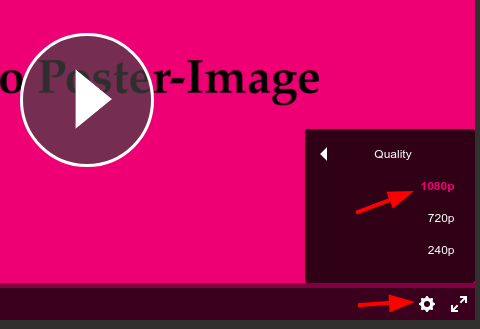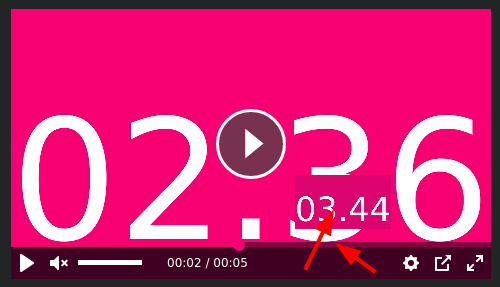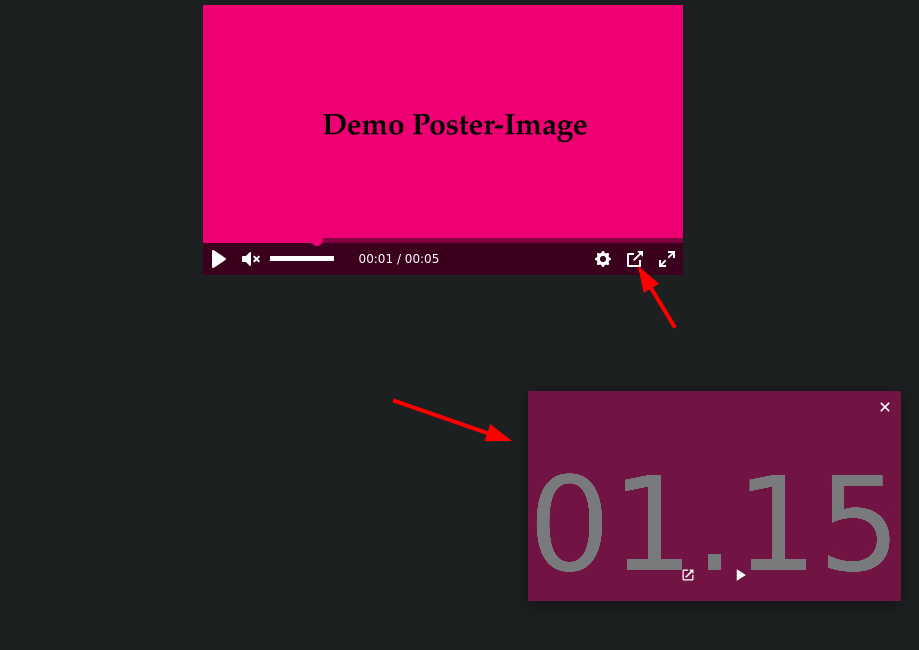stroeer.github.io
Getting Started
Using the hosted files at github pages is probably the easiest way to get started, you simply need to include the following links in your page.
Example HTML and JavaScript
<head>
<link href="https://tonline-mediaplayer.github.io/assets/css/tonline-mediaplayer.css" rel="stylesheet" />
</head>
<body>
<div class="tonline-mediaplayer fixed-ratio ratio-16-9"
data-pip-allowed
data-hover-preview-enabled="https://tonline-mediaplayer.github.io/assets/videos/html-examples/sample-video-240p.mp4">
<div class="containment">
<video
playsinline
muted
poster="https://tonline-mediaplayer.github.io/assets/images/html-examples/poster.jpg"
preload="metadata"
data-clicktarget="video">
<source
data-quality="1080"
data-label="1080p"
src="https://tonline-mediaplayer.github.io/assets/videos/html-examples/sample-video-1080p.mp4"
type="video/mp4">
<source
data-quality="720"
data-label="720p"
src="https://tonline-mediaplayer.github.io/assets/videos/html-examples/sample-video-720p.mp4"
type="video/mp4">
<source
data-quality="240"
data-label="240p"
src="https://tonline-mediaplayer.github.io/assets/videos/html-examples/sample-video-240p.mp4"
type="video/mp4">
</video>
</div>
</div>
<script src="https://tonline-mediaplayer.github.io/assets/js/tonline-mediaplayer.js"></script>
<script>
TOnlineMediaplayerFramework.Init();
</script>
</body>
Example React Component
import React from 'react';
import TOnlineMediaplayerFramework from '@stroeer/tonline-mediaplayer';
import '@stroeer/tonline-mediaplayer/dist/tonline-mediaplayer.css';
export default class TOnlineMediaplayer extends React.Component {
componentDidMount() {
this.player = TOnlineMediaplayerFramework.New(this.playerEl).Finish();
}
componentWillUnmount() {
if (this.player) {
this.player.Dispose();
}
}
render() {
return (
<div className="tonline-mediaplayer fixed-ratio ratio-16-9"
ref={c => (this.playerEl = c)}
>
<div className="containment">
<video
playsInline
preload="metadata"
data-clicktarget="video"
poster="https://tonline-mediaplayer.github.io/assets/images/html-examples/poster.jpg"
>
<source
data-quality="1080"
data-label="1080p"
src="https://tonline-mediaplayer.github.io/assets/videos/html-examples/sample-video-1080p.mp4"
type="video/mp4"
/>
<source
data-quality="720"
data-label="720p"
src="https://tonline-mediaplayer.github.io/assets/videos/html-examples/sample-video-720p.mp4"
type="video/mp4"
/>
<source
data-quality="240"
data-label="240p"
src="https://tonline-mediaplayer.github.io/assets/videos/html-examples/sample-video-240p.mp4"
type="video/mp4"
/>
</video>
</div>
</div>
);
}
}
The order of the <source> tags is important.
It controls the order of the settings -> quality UI.
The data-label attribute is used for the settings -> quality labels text.

The first <source> tag is the default video file.
On mobile, you might consider putting a lower resolution video-file first.
data-attributes
The player can be configured via data-attributes, before calling TOnlineMediaplayerFramework.Init().
- data-fullscreen-disabled
- data-hover-preview-enabled
- data-pip-allowed
- data-programmatic
- data-vast-preroll-adtag
data-fullscreen-disabled
If this attribute is present, the player’s UI won’t have a fullscreen button.
It can be enabled programmatically (via ToggleFullscreen() or EnterFullscreen()) though.
data-hover-preview-enabled
If this attribute is present, it’ll show a small preview of a video frame, when you hover the video timeline.

It uses the default video (the first video source in the html markup) as a preview. That means, that the video could be huge, therefore you can supply a value to the attribute like so:
data-hover-preview-enabled="https://tonline-mediaplayer.github.io/assets/videos/html-examples/sample-video-240p.mp4">
This will force the player to use the smaller video (in size an resolution) for the preview.
data-pip-allowed
Defaults to off. If this attribute is present, It’ll enable the browser’s native Picture-in-Picture mode (if the browser supports it).

See also: https://w3c.github.io/picture-in-picture/.
data-programmatic
If this attribute is present, the TOnlineMediaplayerFramework.Init() method will skip the initialization of this particular player.
You can initialize the player later on with TOnlineMediaplayerFramework.New().
<button id="initNowButton">Init Now</button>
<div id="notInitializedByDefault" class="tonline-mediaplayer fixed-ratio ratio-16-9"
data-programmatic>
<div class="containment">
<video
playsinline
muted
poster="https://tonline-mediaplayer.github.io/assets/images/html-examples/poster.jpg"
preload="metadata"
data-clicktarget="video">
<source
data-quality="240"
data-label="240p"
src="https://tonline-mediaplayer.github.io/assets/videos/html-examples/sample-video-240p.mp4"
type="video/mp4">
</video>
</div>
</div>
<script>
TOnlineMediaplayerFramework.Init();
document.getElementById("initNowButton").addEventListener("click", function() {
TOnlineMediaplayerFramework.New(document.getElementById("notInitializedByDefault"));
this.parentNode.removeChild(this);
});
</script>
data-vast-preroll-adtag
With this attribute, you can supply a VAST preroll adtag.
You can always change or add an preroll adtag programmatically later on with SetVASTPrerollTag().
HOMAD integration
For basic information about how to integrate HOMAD’s Anti-Adblock solution, see here.